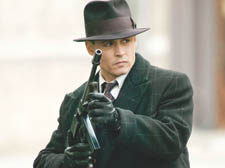|
|
 |
| |

Johnny Depp as John Dillinger in Public Enemies |
A decent shot at Dillinger portrayal
PUBLIC ENEMIES
Directed by Michael Mann
Certificate 15
JOHN Dillinger was a bank robber who gained cult status in 1930s America for his ability to stay one step ahead of the cops – and the fact he targeted the institutions that many saw as the real crooks.
These were the hard years after the Wall Street Crash, when the dustbowl “Okies” were leaving long shameful shadows on the country’s conscience as they trekked west, where Hooverville shanty towns dotted the suburbs and John Steinbeck and Martha Gellhorn railed in print at injustices caused by the onus on self-reliance to fulfil the American Dream.
Dillinger’s crime spree, as this bio-pic shows, had longer lasting effects than raising the spirits of those who were happy to see bankers take a hit: he was used as a pawn by J Edgar Hoover to argue the case for a strengthened FBI.
The gangster broke out of prison and embarked on a 14-month heist-fest across the Mid West that garnered headlines and was used by Hoover to call for greater resources. It eventually prompted fundamental changes in American law. No longer could you head for the county line and be safe that the lawmen’s jurisdiction meant they had to hand over the pursuit to colleagues in another state.
Johnny Depp provides an intriguing Dillinger, although it is hard at times to marry Depp’s soft approach with the fact Dillinger was a violent man earning a living by pointing guns in the faces of tellers, clerks and customers.
We watch him fall for coat-check girl Billie Frechette (Marion Cotillard). Their relationship is one of those cinematically handy love-at-first-sights, which means no screen time is wasted with courting which could be better spent showing shootouts.
However, the tenderness the couple feel for one another is allowed to dramatically come to the fore towards the end, as this love story is an apparently important undercurrent to the Dillinger story, and indeed is meant as a device to show this murderer has feelings too.
The film looks great. The 30s come alive, a mixture of Steinbeck grime – one scene is clearly based on the famous image of the impoverished “Okie” woman nursing a malnourished baby. The splendour of the Art Deco period is in every shot, from the silver grilled running board-decked De Soto cars that Dillinger speeds away in, to the Zenith radios that broadcast snippets of real news from the period, right through to marble foyers and gold-plated bars of the banks he robbed. Throw in such eye candy as Depp and his co-star Christian Bale, and there is plenty to keep your attention.
Sadly, however, there are some flabby bits. The fact is (and this is to be expected of Michael Mann) too much of energy is expended on shootout scenes.
We learn little of Dilinger’s background and even less of his gang. It is a near fatal flaw. It means you have an unhealthy detachment towards the well-being of the characters – a problem when the main protagonists find themselves in life or death situations every five minutes.
Other 30s bank robbing folk heroes also raise their handguns and take aim.
Baby Face Nelson had a hatred of police and got a thrill from letting off salvoes in their direction as he screeched away with a bag of readies.
Nelson’s exploits were a sub-plot in the Coen brothers superlative O Brother Where For Art Thou?, and his character was far more interesting in the George Clooney comedy than the silent madman portrayed in Public Enemies. One theory is the actor – Liverpudlian Stephen Graham, last seen popping up in The Damned United as Billy Bremner – was not too comfortable with Nelson’s broad Southern drawl. It would explain how someone with a fair amount of screen time utters no more than 10 words in total as he sprays various places with bullets. |
 |
|
 |
| |
|
 |
|

